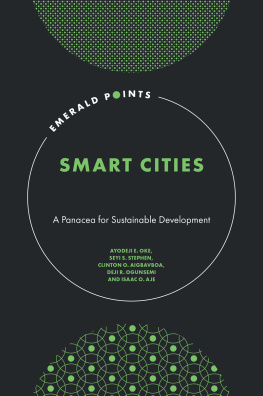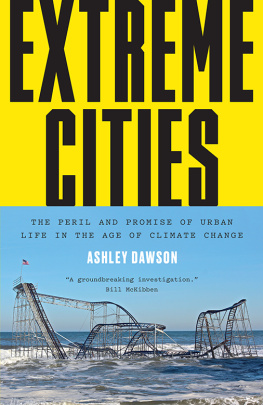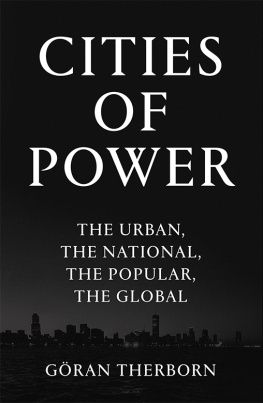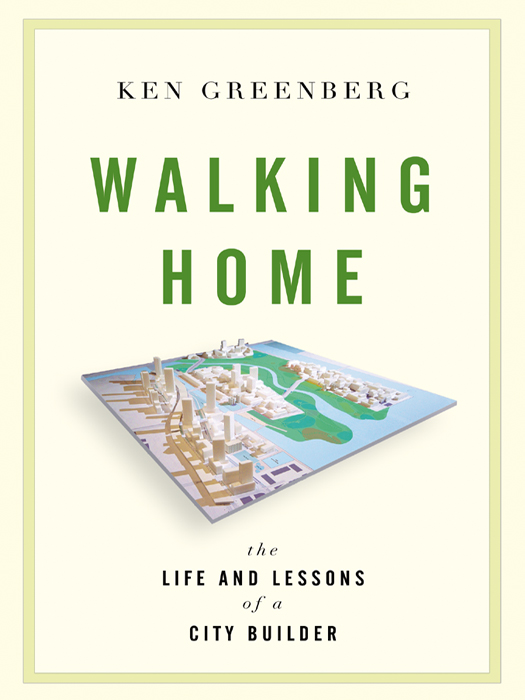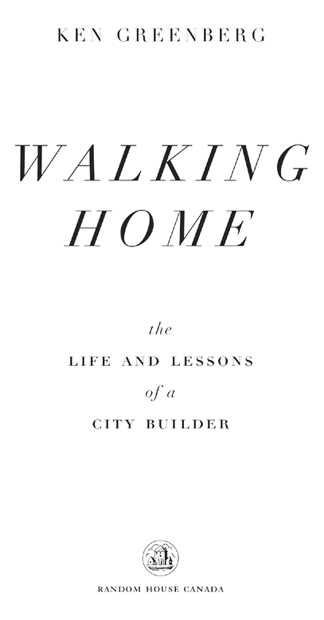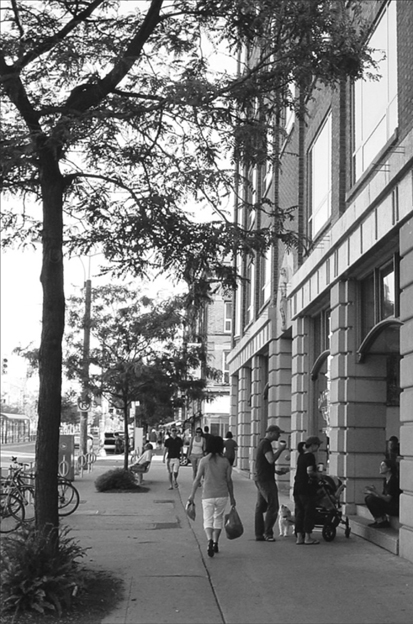
PUBLISHED BY RANDOM HOUSE CANADA
COPYRIGHT 2011 KEN GREENBERG
All rights reserved under International and Pan-American Copyright Conventions. No part of this book may be reproduced in any form or by any electronic or mechanical means, including information storage and retrieval systems, without permission in writing from the publisher, except by a reviewer, who may quote brief passages in a review. Published in 2011 by Random House Canada, a division of Random House of Canada Limited, Toronto. Distributed in Canada by Random House of Canada Limited.
www.randomhouse.ca
Random House Canada and colophon are registered trademarks.
Library and Archives Canada Cataloguing in Publication
Greenberg, Ken
Walking home: the life and lessons of a city builder / Ken Greenberg.
eISBN: 978-0-307-35816-5
1. Urban renewal. 2. Urban cores. 3. Inner cities. 4. City planning. 5. Sustainable urban development. I. Title.
HT 170.G74 2011 307.342 C 2010-904239-5
Cover image: Lower Don Lands Design Team, Mack Scogin Merrill Elam Architects
Photo credits: see .
v3.1
FOR ETI, A CITY GIRL
CONTENTS
INTRODUCTION
T hink of Broadway as it follows New York Citys progress from the tip of Lower Manhattan up the Hudson River or Yonge Street running north, bisecting the heart of Toronto. Consider Commonwealth Avenue wending its way west out of Boston through Brookline then Newton to Route 128 or Woodward Avenue making its way north from the heart of Detroit out past 8 Mile. Picture one of the Parisian Grand Boulevards extending beyond the Priphrique into the vast banlieues. Choose any familiar equivalent in another major city. Though unique in ways, the scenes we would encounter while walking along any of these streets, from their origins in the historic core out to their suburban fringes, would have much in common.
We begin downtown, where the streetscape is snug and compact. The distance from one sidewalk to the unbroken line of building facades on the other side of the thoroughfare is short, and we easily make out expressions on the faces of people across the street. The city blocks are narrow and traffic moves slowly, stopping at frequent traffic signals. Lanes are few and tight, and drivers accustomed to the presence of pedestrians and cyclists know enough to watch for them. When we see something interesting or someone we know on the opposite sidewalk, we can effortlessly cross at a light or jaywalk during a break between cars. Cyclists and drivers make eye contact with us when we negotiate intersections, letting us know that they are as aware of our presence and mindful of our safety as we are of theirs. At frequent intervals, we can shorten our walk and jump on transita bus, streetcar or subway train. As we walk, much catches the eye. Most buildings extend right to the sidewalk, and their ground floors are occupied by shops, restaurants and cafs with closely spaced doors and appealing window displays. Offices and residences above the stores contribute a constant flow of people to the busy sidewalks, which are alive with pedestrians of all ages and interests. Some hurry; others stroll and window-shop. Where the sidewalks are wider, we can linger at a caf terrace and watch the passing flow. A canopy of trees or awnings may provide shade and shelter. Traffic signals, advertisements and store signs are directed at pedestrians, who also have easy access to newspaper boxes, newsstands, benches, planters, food vendors and, occasionally, impromptu markets or hawkers with tables of knock-off goods.
As our walk takes us out of the historic city centre and into areas that were built more recently, this pedestrian-oriented streetscape begins to change. The basic ingredients remainthe stores, the street hawkers, the residences abovebut their form and relationships alter almost imperceptibly, block by block. The roadway pavements gradually expand with more and wider lanes. Sidewalks and other pedestrian spaces contract. At intersections, exclusive left-turn lanes increase the distances we have to walk to get across the street, as do free-flow right-turn traffic lanes called dog legs. The blocks get longer, and the distance between safe crossing points increases. Eye contact is lost to distance and increased velocity, and we feel much less inclined to impulsively cross the street to check out a tempting shop window on the other side. Slower-moving seniors, the disabled and people pushing strollers or pulling shopping carts all have to struggle to make it across the street before the light changes, urged on by the flashing timers warning us to clear the intersection. Here, the balance between drivers and pedestrians has shifted. We persevere and continue on our walk.
Gaps begin to appear where missing buildings have given way to parking lots. Our journey is becoming much less appealing. The stores are bigger, with fewer doors and windows to invite spontaneous browsers inside; many are now single- or two-storey buildings, with less discernible or totally nondescript occupancy above. We have to keep a wary eye out for cars crossing our path because the sidewalk is broken up with frequent curb cuts for parking and service entrances. The buildings themselves are set back farther from the sidewalk. The remaining window displays are dwarfed by signs standing at the curb or mounted high on the buildings, designed for drive-by viewing. The street may be busy, but here on the sidewalk, we pedestrians are starting to feel a little isolated. A few more kilometres out and the walls of the street start to recede even more. The roadway has become even wider. Shopping plazas sit even farther from the sidewalkacross parking lots, with no pedestrian route to the shop doors. Few trees shade the narrow sidewalk, and an eclectic mix of pavement surfaces keeps breaking our rhythm as we pass gas stations and drive-thrus at larger intersections. We are in a world visually dominated by back-lit signboards. We are clearly in another country. We are meant to drive here. The street is no longer recognizable as a shared public space; it is a single-purpose traffic artery. Malls replace plazas and storefronts are barely visible from our narrow perch on the vestigial sidewalk. The only signs we can see are the corporate logos on otherwise undecorated walls or large post-mounted billboards.
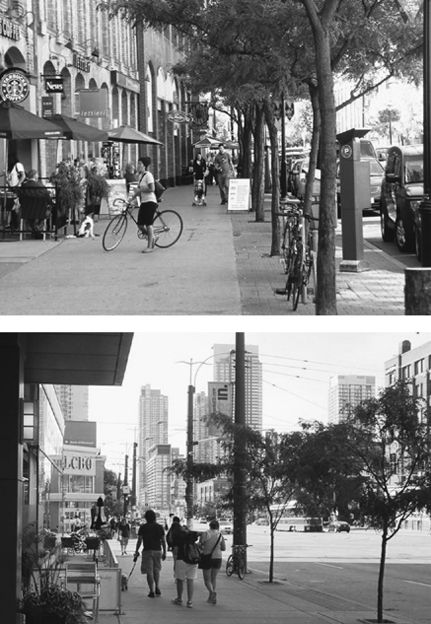
The walk out of the city, from streets with lively sidewalks
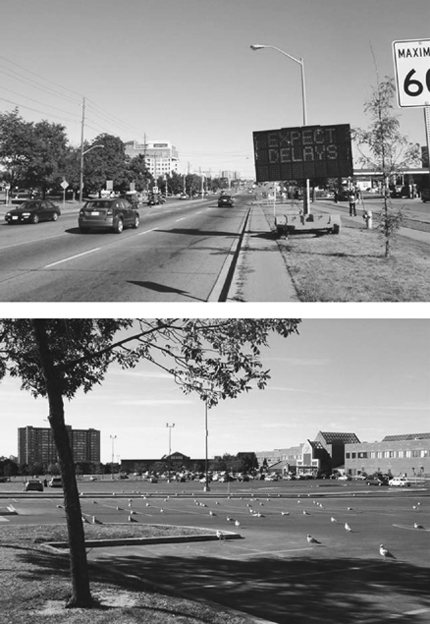
to forlorn traffic arteries lined with parking lots.
Since no one is expected to walk here, this environment has been constructed with little regard for weather. On a hot and sunny or cold and windy day, this walk goes from being merely unpleasant to downright inhospitable. Walking itself has become dangerous. Intersections are spaced far apart, and jaywalking would be much like running across a highway. And when we do come across an intersection, it comes fully loaded with multiple left turns and even wider free-flow dog legs with large radii for higher-speed right turns. There is so little pedestrian time on the signals that the streets are almost uncrossable. Now, unable to keep up with the speed and single-mindedness of the traffic, cyclists have also become rare, just a few brave souls precariously hugging the curb. Forlorn and isolated bus stops are splashed with advertising. As we trudge on through this hostile territory at the side of the road, we see that human activity has withdrawn from the street. It happens only in the private places where people live, work or shopin separated, self-contained compounds. Big box stores and power centres alternate with office parks surrounded by their own massive parking pads. Low-density residential enclaves defensively turn their back fences to the traffic artery (the reverse frontages that signal surrender in this harsh environment), with blank walls and fences shielding their backyards from traffic. A little farther and there will be no more sidewalks. The public social spacesthe forecourts, doorways, caf patios, sidewalk displays, where we meet and connect and that make the city feel convivialare gone. The walk from the house to the mall is either practically impossible or completely discouraging. These last stages of our journey have been a bit like walking onto the tarmac of an airfield or into the tunnel from the subway platform: the signs and signals that exist are meant for creatures of another order. How did this happen?





